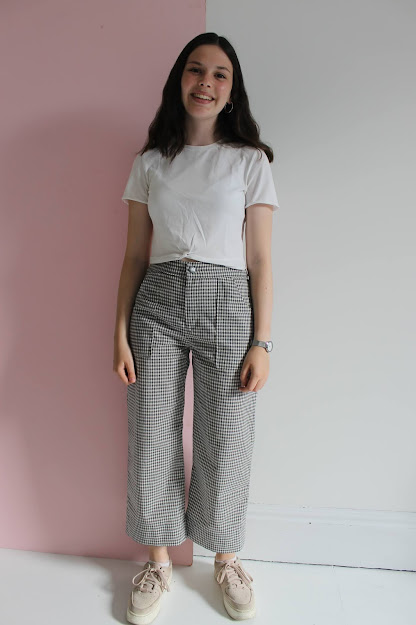This zip-up hoodie is the kind of wardrobe staple that I wear over and over again. I think that it's easy to avoid making basic clothes when bright fabrics and interesting patterns are there to distract, but I really enjoy making something that I know will be worn again and again. That's not to say I don't enjoy sewing something a bit exciting from time to time though!
Last year, I bought myself a ready-to-wear grey zip-up hoodie. Since then, I've worn it again and again as a way of easily adding an extra layer. Instead of buying a second one, I wanted to try and make one. I chose to make a black one as, like grey, it's a colour that goes with a lot of clothes that I already own and can easily be worn as an outer layer.
Plain fabrics get a bit of a bad reputation for being 'boring', especially when sewing. Obviously, a plain t-shirt isn't the most exciting of makes but with a design like a hoodie, there are so many surprising ways to add interest. With this hoodie, instead of using the same fabric for the entire thing I've added in ribbing for the cuffs and hem-band as well as tape for the drawstrings. The zip and metal disk also add extra detail, meaning that there are several different textures. I did consider adding a patch to add a bit more colour but decided to keep it simple as I'm not actually trying to make the most interesting hoodie in the world, just a hoodie that I know I'll wear a lot!
When making something simple, I think the most important thing is to use the right fabric. I used this black French Terry fabric from Fabrics for All which is the perfect weight for a hoodie. It's thick enough to add warmth and hold the shape of the hoodie without being bulky. The fabric also feels so nice and has retained its colour well after being pre-washed. But if I was going to give this fabric an award, it would be for how lovely the wrong side of the fabric is! There's nothing worse than a fabric that looks nice on the outside but feels horrible to wear next to the skin. Not only is the wrong side nice and soft, it also looks nice which is so important for this make as I'll be wearing it unzipped most of the time and the inside will be visible.
As strange as it sounds, I think that the cuffs might be my favourite part of this make! One of the main ways in which shop-bought and homemade clothes differ is in having notions that perfectly match the fabric. It's easy to buy a top with a matching zip but much harder to buy a zip in the exact colour of your fabric. This is the same for ribbing. In the past, I've tended to just use the same fabric for the cuffs and hem band of a jumper but I've always wanted to use a matching rib to make it look a bit more professional. I really wanted my hoodie to have this professional feel, and so I ordered this black rib from Fabrics for All to go with the French Terry. I'm so pleased with how it looks - the two fabrics match perfectly!
There is one final touch that I added to complete this make - a metallic disk. This is something that I completely copied from the RTW hoodie that I already own. I love it when high-street shops add little details like this and also love adding them to my makes. This is a plain silver disk that I sewed on near the side seam, a really quick addition which makes me smile every time I see it.
I wasn't expecting to feel so proud of this make but in really taking my time over the details (especially the topstitching!) I've made something that I really like. It doesn't take a lot to turn a make from something boring into something a lot more special. Knowing that I was going to wear this a lot also made the sewing process a lot more enjoyable as it provided a reason for taking my time over small details.
This fabric was gifted to me by Fabrics for All as part of their blogging team, but all thoughts and opinions are my own.


























